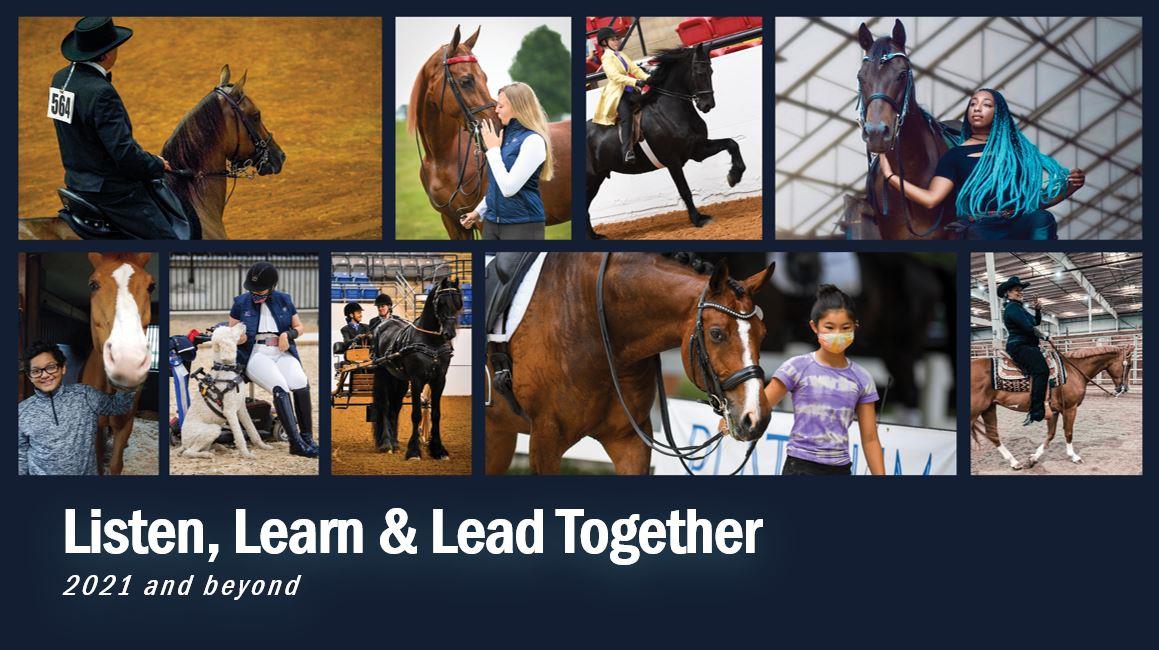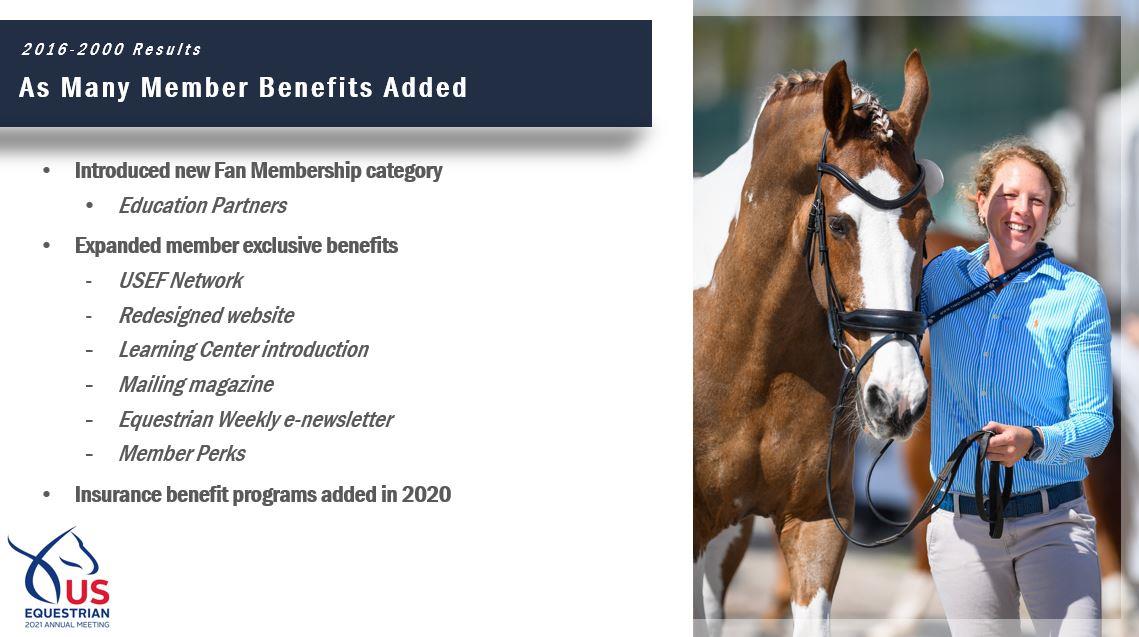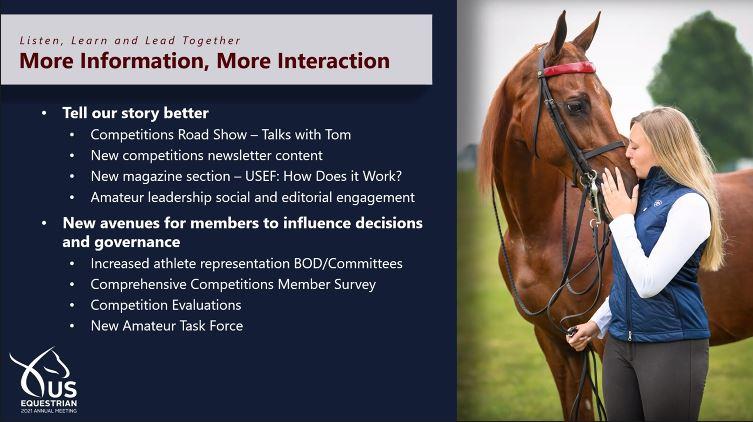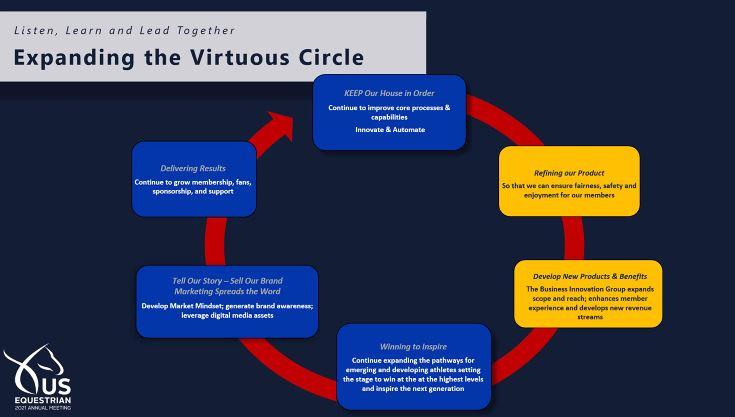
President Murray Kessler and President-Elect Tom O’Mara delivered the 2021 General Session presentation on Saturday afternoon celebrating the new heights equestrians have achieved in recent years and laying out the ambitious plans for continued growth and collaboration in the future behind the theme of Listen, Learn and Lead Together. Kessler looked back at how far US Equestrian and equestrian sport have come in the past four years, even with the challenges posed by 2020. O’Mara stepped into his new role by getting right to business, reporting on the competition environment member survey results and communicating key priorities and the evolution of the strategic plan.
US Equestrian’s Progress from 2016 to 2020
President Murray Kessler reviewed the progress from 2016 to 2020, which focused on eight main issues: stagnant to declining membership, flat revenues, perceived lack of benefit to members, resentment of high-performance funding, a para-equestrian team needing funding and a competitive boost, costs-prohibiting broad access, many process challenges, and safety and fairness concerns. Kessler developed a strategic plan with a clearly defined approach to address these issues, highlighting the joy of horse sports in the process.
“The key is to develop a virtuous circle, a reinforcing circle. Once you start to get momentum, it builds on itself year after year after year,” said Kessler. He noted US Equestrian’s virtuous circle focuses on getting our house in order, defining our product, winning to inspire, telling our story, and delivering results.

Membership more than doubled during Kessler’s tenure, reaching over 189,000 members in 2019, and increasing revenue as well. The new fan membership category, expanded member-exclusive benefits, and the insurance program added value to US Equestrian members and sponsors as well. A marketing makeover celebrated the universal joy of horse sports and increased interest in US Equestrian, leading to over 1 million followers on social media platforms. The shift in focus to “winning to inspire” brought new pathways for youth, increased USEF national championship participation, and contributed to consistent medal-winning moments on the world stage. U.S. Para Dressage saw significant success with numerous top placings, including number one FEI World Rankings for athlete Roxanne Trunnell and the U.S. team, and the launch of the Para Coach Certification Program. Access to and cost of equestrian sport were addressed with the implementation of fan memberships, Competition Lite, and the development of the USEF Diversity, Equity & Inclusion Plan and the elimination of the 10-mile mileage rule.
Processes at US Equestrian also drastically improved over the past four years. The website was upgraded and many processes were automated, creating user-friendly experiences. The new headquarters building was completed, the Compliance Department was established, and improved staff development programs were implemented. Committee structures were streamlined and the rule change process was simplified, while the new licensed official licensing process delivered an increase in approval rates.
Fairness and safety reached new heights in recent years. Safe Sport training was put into place to comply with new federal law and minor athlete abuse prevention policies were created. Bylaw and rule changes to the Grievance & Regulatory process allowed for an improved experience. The lab was outsourced to University of Kentucky, and the Helmet Safety Fund goal of $450,000 was achieved.
While 2020 looked to be a promising year, the global COVID-19 pandemic and other issues posed numerous challenges. Competitions stopped for 11 weeks, causing business interruptions that led to a 25% loss in USEF revenues. Unfortunately, staff reductions were a very difficult necessity. In addition, social justice issues nationwide brought forward important discussions and concerns.
US Equestrian rose to the challenges brought on in 2020 under Kessler’s guidance. The COVID-19 Action Plan enabled a safe return to competition beginning June 1. While 925 competitions were cancelled, 1367 competitions successfully took place.
“Through the year we were able to run about 65% of the total competitions; 1367 competitions still ran in the height of the pandemic. By the way, we did it successfully,” said Kessler. “I am going to thank the organizers again; they took it seriously. I want to thank the members and competitors. I recognize that it is hard sitting out there in the middle of the summer wearing a mask when it is 95 degrees out, but you did it and we kept our sport open, so good for you.”
Other adjustments in 2020 involved creative digital content that helped engage members and keep sponsors, and negative financial impacts were minimized. The USEF Diversity, Equity & Inclusion Action Plan was developed and approved as the organization looks to the future.
Kessler closed out his portion of the presentation with some final thoughts on his time as the President of US Equestrian. “I will tell you that through my work volunteering on [the North American Riders Group], to being on the board, to the last four years being the president of the board, it has been one of the greatest honors of my life to serve you,” he said. “I will tell you that these four years have been a heck of a ride for me. I will quote Winston Churchill; it is not the beginning of the end. The work that we did over the last four years, and at this moment as I turn over the reins, it is just the end of the beginning. There is much, much, much more work to do in this sport; there is no stopping how we can grow it, and the man to make that happen is Tom O’Mara.”
US Equestrian’s Growth Opportunities for 2021 and Beyond
President-Elect O’Mara enthusiastically stepped into his new role with US Equestrian. O’Mara, a banking and business development professional and self-proclaimed horse show dad, wants to capitalize on US Equestrian’s strong foundation by ensuring our actions support our members and their horses, exploring opportunities to grow membership and results, and increase sustainability by diversifying revenue streams. He plans to achieve these goals by gathering continuous member feedback; having open, informative, and ongoing conversations between USEF leadership and members; using data-driven and business-based approaches; and allowing member, sport, and overall organization value to drive decisions.
“Member feedback has always been important and is very necessary, and it will continue,” said O’Mara. “We have done a number of things recently to get even more feedback from folks and there has been a lot of adjustment happening right out of the chute. I feel that member feedback can’t really be only based around crisis situations. It really does need to be a continuous action.”
O’Mara pointed out the Competition & Conversation Series as one example of US Equestrian listening to its members. The interactive video sessions began in early December 2020 and will continue into 2021 with member feedback provided to the Competitions Task Force. The task force will use information collected and evaluate calendar management including mileage, competition standards, compliance, and evaluations for today’s environment.
The comprehensive competition environment member survey sent to competing members in December 2020 will provide additional helpful information to the Competitions Task Force. Members emphasized the importance of safety, rules, and fairness, with responses focusing on keeping competitions safe for horses and exhibitors, maintaining rules/regulations for competitions and a level playing field, and keeping the sport clean of banned substances.
“I refer to [these initiatives] as intangible because they are hard to see every day,” said O’Mara. “These rules and processes have been created by our members and our affiliates over 50 years. It took a lot of time and effort from a lot of people volunteering to get those to where they are. They are very important, even though we don’t talk about them day in and day out.”
Members also viewed the USEF Online Rule Book, USEquestrian.org, USEF Equine Disaster Relief Fund, USEF Network, and US Equestrian news releases as the top products or services. They shared that location/distance, cost, and footing are their top decision factors for choosing a competition.

O’Mara noted that US Equestrian is committed to listening to members and sharing more on how competition processes work. “We have, we are, and we will listen, learn, and lead together with more information and more interaction,” said O’Mara. “We are going to continue to work on this going forward.”
US Equestrian will aim to tell our story better through a competitions road show, with O’Mara traveling to competitions around the country; new competitions newsletter content; and a new magazine section titled “USEF: How Does it Work?” In addition, new avenues for members to influence decisions and governance will be made possible by increased athlete representation on the board of directors and committees, the comprehensive competition environment member survey, competition evaluations, and amateur-focused editorial and social media campaigns.
Next, O’Mara focused on growing equestrian sport and further spreading the joy of horse sports. With 27 million people riding horses in the U.S. each year, O’Mara wants to think big and grow US Equestrian membership to 1 million. He plans to reach this goal by exploring targeted strategies aimed at acquiring new members, including:
- A new associate membership category for grooms, farriers, show staff, and veterinarians;
- Automatic fan membership renewals;
- Health insurance association partner program;
- I Am US Equestrian marketing campaign;
- New affiliates and member conversions;
- Partner and sponsor fan promotions;
- USEF Diversity, Equity & Inclusion Action Plan outreach;
- USEF Network content maximization;
- Social media marketing test.
O’Mara also hopes to diversify the revenue sources for US Equestrian. Looking at the 2019 revenue, 18% was funding driven, while 82% was fee driven. Five out of six main revenue streams are competition-driven, correlating directly to the number of events, classes, and participants. The other main revenue stream is sponsorship, which is still closely related to competitions. O’Mara explained that competitions are the main lever to help grow revenues for US Equestrian as a business. He will grow revenue by positioning and leveraging existing USEF assets to new target markets, becoming a more broadly recognized sport resource and lifestyle brand, and identify new sources of revenue that achieve significant scale through partnerships with others.
O’Mara wants to set US Equestrian up for success in the future with three business lines: sport, member services, and a new business innovation group. Each business line will have goals, a profit & loss statement, and adopt a market-driven business mindset. The business innovation group (BIG) is a new opportunity with three areas of focus: media/licensing, technology/data, and education. The BIG will identify and drive new revenue sources that increase our reach, our visibility, our revenues, and, ultimately, our membership.

O’Mara will expand the virtuous circle that drove the strategic plan during Kessler’s tenure, by refining US Equestrian’s product and developing new products and benefits. Overall, O’Mara’s strategic plan will:
- Build on our strong foundation,
- Develop new products through innovation/partnership and outsourcing,
- Strengthen the sport with new opportunities at all levels,
- Sell our brand and reach new markets,
- Become financially diversified,
- Optimize the existing talents and assets of US Equestrian.
“There are a lot of new ideas coming forward. We have to continue and not lose focus on what we do. We are not going to lose focus on what we do,” said O’Mara. “All of this is being done to support US Equestrian’s vision: to bring the joy of horse sports to as many people as possible.”
Watch the full General Session and more from the 2021 US Equestrian Annual Meeting on the USEF Network.
Stay up to date with the 2021 Annual Meeting by following US Equestrian on Facebook, Twitter, and Instagram.


